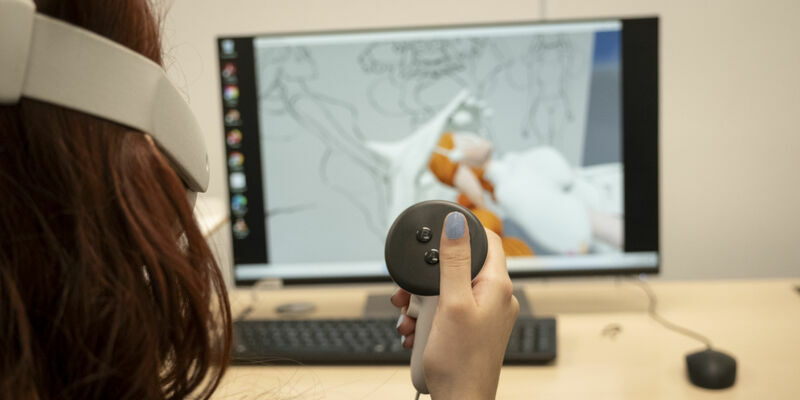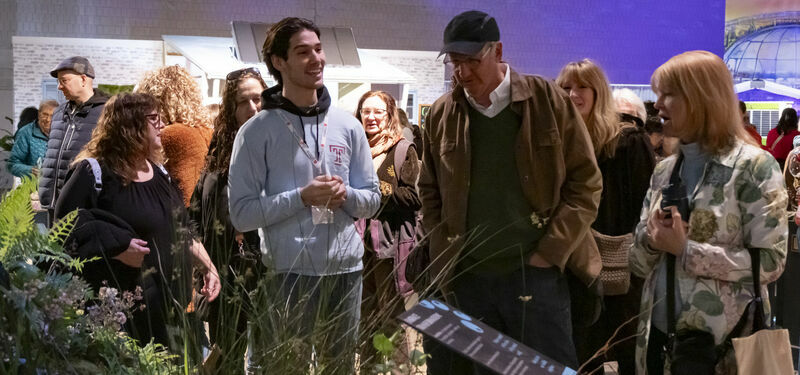Tyler visiting artist combines art, science, horticulture and history
The Jack Wolgin Visiting Artist Sam Van Aken is best known for his “Tree of 40 Fruit”—a single grafted tree that produces 40 varieties of peaches, cherries, apricots, plums and other stone fruits.

Budding trees, eager hands and the hum of creative energy filled the air as students grabbed their grafting tools and got to work. Buckets of rootstocks lined the classroom as contemporary artist Sam Van Aken, Tyler School of Art and Architecture’s eighth annual Jack Wolgin Visiting Artist, kicked off a series of experiential workshops and seminars integrating art, science and horticulture in a way only he could.
“Sam’s singular ability to merge art and plant science, paired with his talent for engaging students, made him an ideal candidate for our artist residency,” said Susan E. Cahan, dean of Tyler School of Art and Architecture, a school encompassing art, design and built environment disciplines.
Cahan has followed Van Aken’s works for more than 15 years, watching this project grow from the early experimental stage to its current state of worldwide impact. Last year, Van Aken worked in Crete to restore an ancient forest.
“Sam’s visit enables Tyler to expand its offerings in meaningful cross-disciplinary, hands-on learning and enhances our world-class curriculum,” Cahan said.
Internationally known for his “Tree of 40 Fruit”—a single grafted tree that produces 40 varieties of peaches, cherries, apricots, plums and other stone fruits—Van Aken spent the week of March 10–14 sharing his passion and knowledge with landscape architecture, horticulture and visual arts students at Temple’s Ambler and Main campuses. As part of his residency, he will return to both of Temple’s campuses over the next two years to offer additional learning opportunities, to plant a “Tree of 40 Fruit” in Ambler’s arboretum, to care for the trees at both sites and to deliver a public lecture on the cultural history of fruit in the Philadelphia region.
The week of programming provided students and the public with opportunities to engage with Van Aken’s unique merging of contemporary art, environmental science and technology. The week culminated in the installation of one of Van Aken’s rare trees—the first of its kind in the Philadelphia region—in Tyler’s central greenspace courtyard, adjacent to the school’s natural dye garden.
 (Photography by Ryan S. Brandenberg)
(Photography by Ryan S. Brandenberg)
In Ambler’s Dixon Hall, Van Aken’s passion for grafting—and its deep historical roots dating back to 1800 B.C.—quickly enabled a class of 20 junior and senior horticulture and landscape architecture students to apply their education in grafting to a project that traces the cultural history of fruit in the region, including indigenous and introduced varieties.
After mapping the historic transatlantic traversing of fruit trees through generations, Van Aken summarized what was at the core of his fascination. “For me, what’s become really interesting in my discovery process is that these heirloom fruits aren’t just agricultural products. They are cultural objects and embedded in them aren’t just nutritional aspects or tastes, it’s actually the history of civilizations around the world.”
While digesting the heavy weight of the history that fruit holds, each student grafted their own pit fruit tree, practicing the delicate skill of splicing branches to create new life.
“Bringing an artist to campus whose medium is trees is such an exciting opportunity,” said Sasha Eisenman, associate professor of horticulture and chair of the Architecture and Environmental Design Department. “Seeing how art, science and nature intersect is valuable for our students as they navigate their careers and align their passions with their professional pursuits. Horticulture, in its many forms, provides opportunities to positively impact both the environment and people’s lives.”
In Tyler’s courtyard on Main Campus, Van Aken led a hands-on workshop creating botanical cyanotypes—distinctive cyan-blue prints created by a photographic process that uses a light-sensitive solution and UV exposure. Students from the Glass, Photography, Fiber Arts and Printmaking departments worked elbow to elbow with each other and Van Aken using natural light to expose their cyanotypes on fabric and paper, exploring the possibilities of blending organic materials with artistic techniques.
 (Photography by Ryan S. Brandenberg)
(Photography by Ryan S. Brandenberg)
Junior photography major Jami Deluca was particularly inspired. “I’ve been working with cyanotype in class for a few months now, preparing for this visit, but seeing someone so masterful with the process was incredible,” Deluca said. “Talking with Sam, I realized he’s almost like a detective—tracking down rare plants, researching their history and preserving them through his work. We see the finished cyanotypes, but behind them is this deep scientific process, from gathering materials to the chemistry of printing. It’s a whole new way to think about art.”
That excitement of discovery and spirit of collaboration extended into Associate Professor Bryan Satalino’s design and illustration class, where students took on a real-world design challenge—creating a 20-page care manual for Van Aken’s grafted trees. Working in teams, they developed visually engaging and user-friendly guides, which Van Aken will ultimately select from to be distributed to caretakers of his living sculptures across the country.
“It’s so exciting to see the teams working together, pushing themselves and each other to think and create in new ways,” said Satalino. “This project challenges them to consider not only aesthetics but also clarity, usability and functionality—key elements in any professional design project.”
As Van Aken’s two-year engagement with Temple continues, his work will remain an inspiration for students eager to explore the unexpected intersections of their fields. “This was more than just a week of workshops and lectures,” said Nichola Kinch, associate dean of academic affairs at Tyler, who worked closely with Van Aken to coordinate the week of diverse, interactive learning experiences.
“Sam’s visit sparked an ongoing dialogue—one about art, science and the ways in which nature connects us all."
—Amanda Mandia


